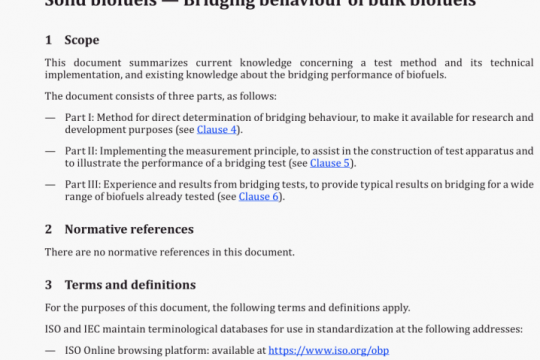ISO/TS 10986-2021 pdf free download
ISO/TS 10986-2021 pdf free download.Plastics piping systems – Glass- reinforced thermosetting plastics(GRP) pipes一System design of above ground pipe and joint installations without end thrust.
5.5 Maximum support spacing
5.5.1 General
This subclause provides guidance on computation of pipe stresses and deflections as well as requirements for pipe buckling stability for pressure pipes installed above ground on supports at intervals to determine maximum support spacing.
A pressurized water column by itself is unstable. The stability of the pressurized water column is provided by the axial stiffness of the pipe.
The water column within a pressure pipe carries an axial pressure thrust. In a flexible, non-restraint joint piping system, this axial pressure thrust is restrained by external anchoring but not by the pipe itself. The axial thrust does, however, typically affect the stresses and deflections of an above ground pipe to a significant extent. The thrust affects the bending moments and deflections of the pipe. Pipe bending moments and deflections shall therefore be computed using beam-column formulation. Ultimately, an above ground pipe with flexible, non-restrained joints can buckle as a column if not properly supported.
To determine the maximum support spacing for a pipe the following forces, stresses and deformations shall be computed and checked against allowable limits:
— maximum total axial compressive force acting in the pipe and the water column to be checked against global buckling of pipe as a column;
— maximum axial tensile stress acting in the pipe wall to be checked against allowable stress;
— maximum pipe deflection (sagging) to be checked against allowable deflection;
— maximum pipe end rotation to be checked against joint capacity for angular deflection accounting for installation tolerances.
Both long- and short-term loading conditions need to be analysed.
As the critical force for a long-term load is lower than the critical force for short-term, both long- and short-term loading conditions need to be analysed.
The dead weight of fluids and some environmental loads result in loading perpendicular to the pipe whilst loads from the dead weight of the pipe and external loads such as snow act vertically (see 5.2.2). A combination of vertical and perpendicular loads give the largest sum for a horizontal pipe therefore the horizontal case should be assumed for general evaluation of a project.
In order to limit the complexity of calculations, loads are classified as being either short-term or long- term. Long-term loads cause creep and the apparent axial long-term modulus shall be used to calculate long-term deflections. It is assumed that short-term loads do not cause creep and a short-term modulus with an aging factor (and where appropriate an environmental factor) is used to estimate deflections.
The apparent axial long-term modulus shall be determined according to the procedures in ISO 4152.
Loads can be classified as longitudinal or perpendicular to the pipe direction. Angular deviation at the
coupling produces a perdendicular component from the longitudinal force acting on the end of the pipe.
5.5.2 Perpendicular forces
The typical perpendicular loads acting on the pipe are the dead weights of the pipe and the fluid in the pipe, environmental loads (e.g. snow, wind), and live loads (e.g. people, traffic, construction), as well as seismic loads.
5.5.3 Forces due to angular deviation
Angular deviation, a, between the pipe and coupling creates a lateral force, Vi,, on the end of the pipe. When evaluating this force, maximum angular deviation should be assumed in the most unfavourable direction, considering rotation of the pipe end due to deflection. This lateral force can be calculated using Formula (8).
VP=FA.tana (8)
where
FA is the total axial force;
a is the angular deviation.
5.5.4 Axialforces
5.5.4.1 General
The typical axial loads are those created by the fluid static pressure, the dynamic pressure (resulting from head loss or surge) and friction forces induced in the pipe at the coupling or pipe support by axial movement of the pipe resulting from temperature or pressure changes.
5.5.4.2 Axial forces due to pressure
Internal pressure results in force acting in both the fluid and the pipe. The working pressure, p, can be considered as creating a long-term load whereas the surge pressure, and the field hydro-test pressure will create a short-term loading condition.ISO/TS 10986 pdf download.




